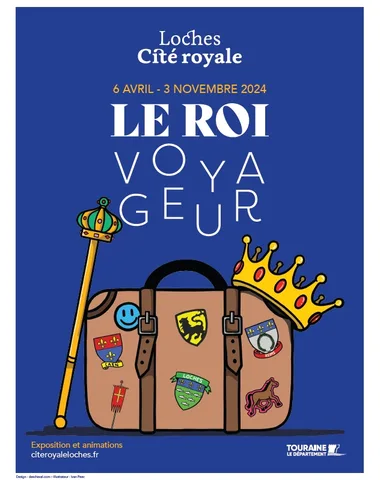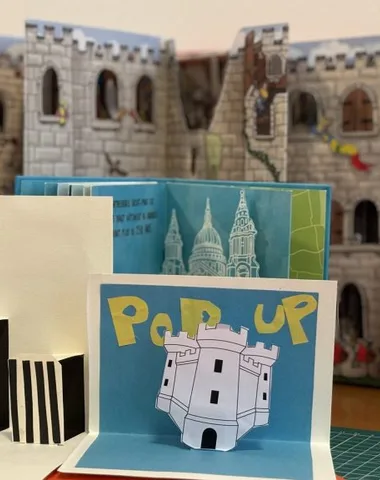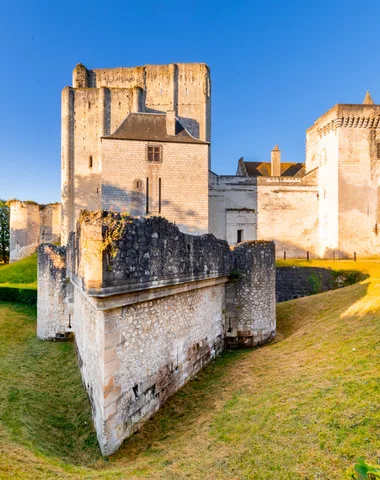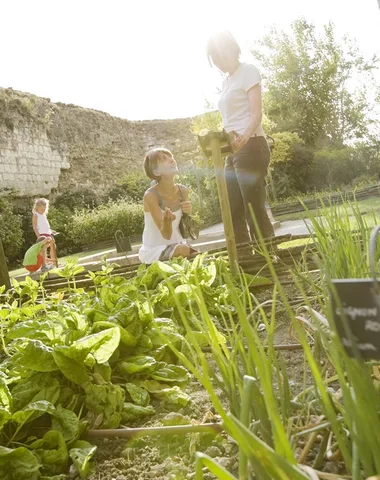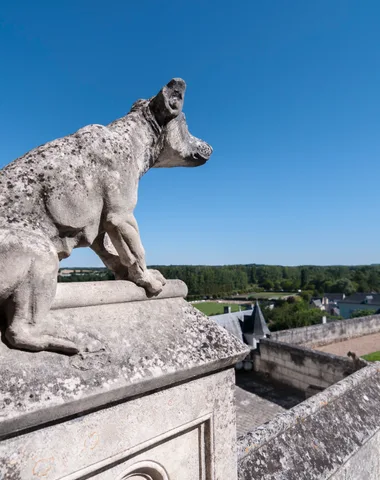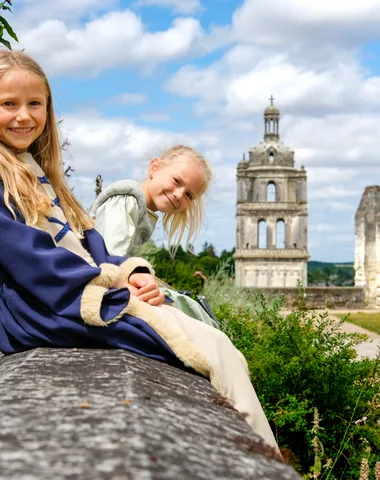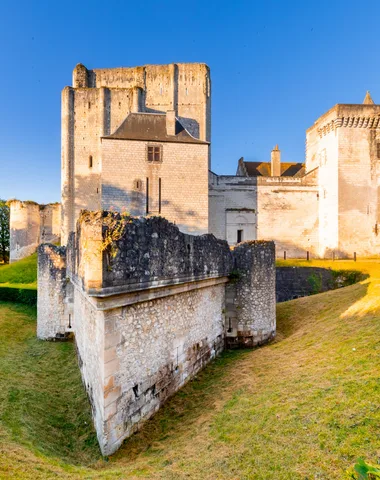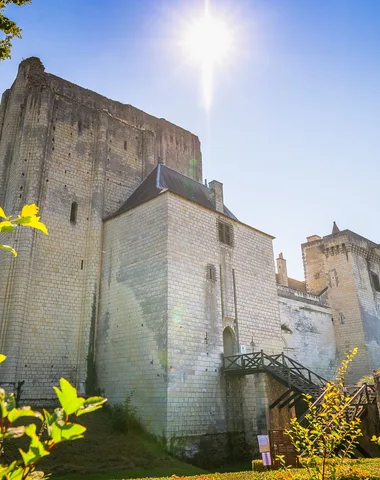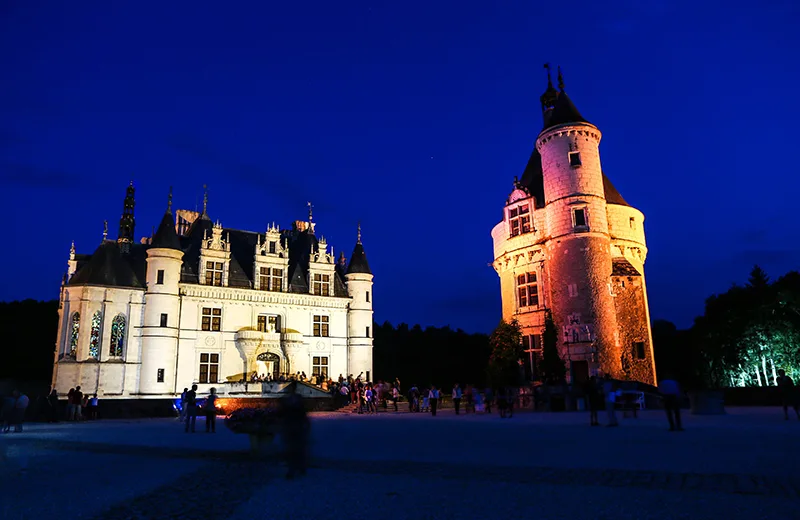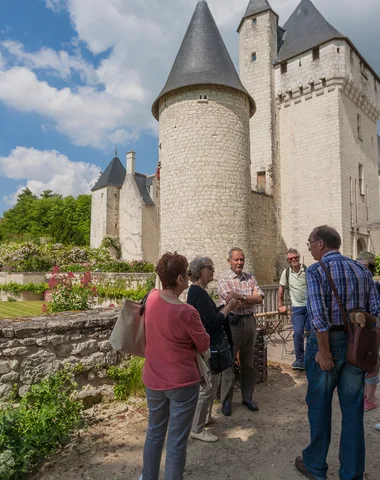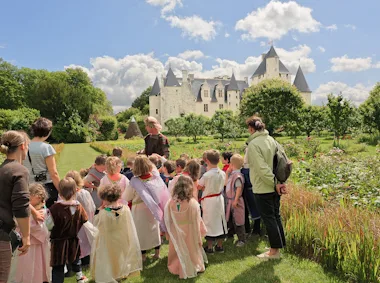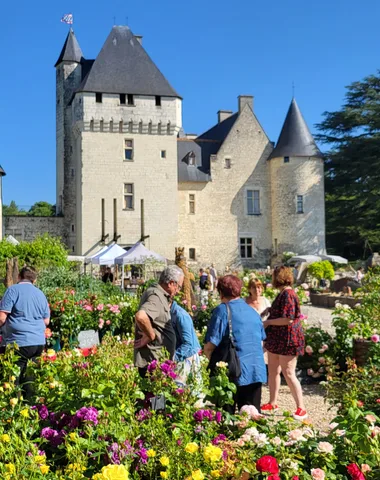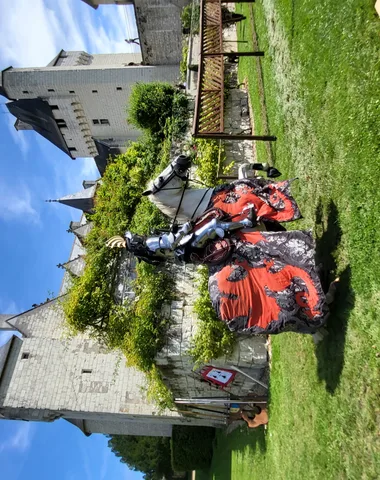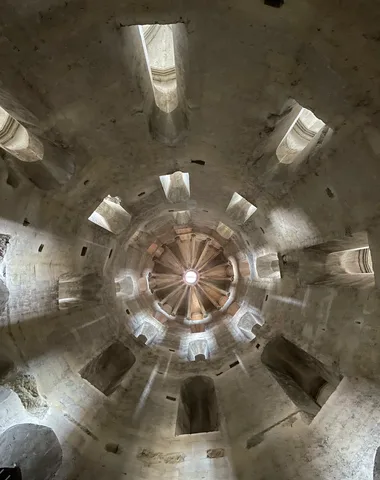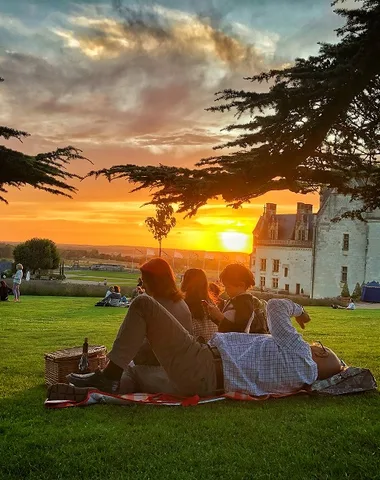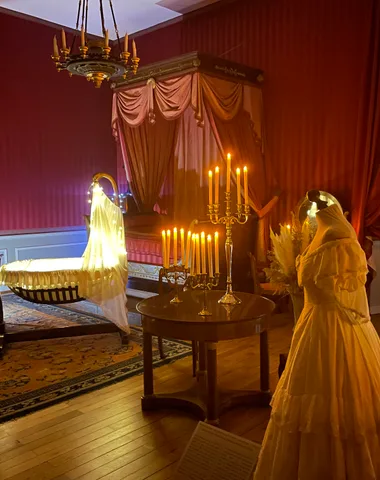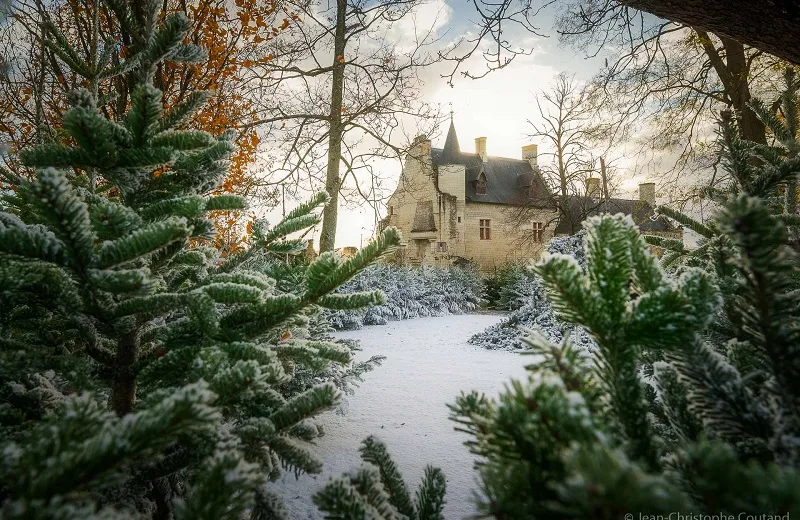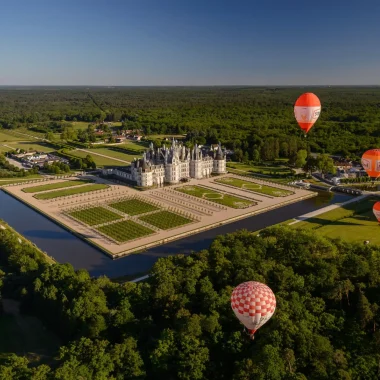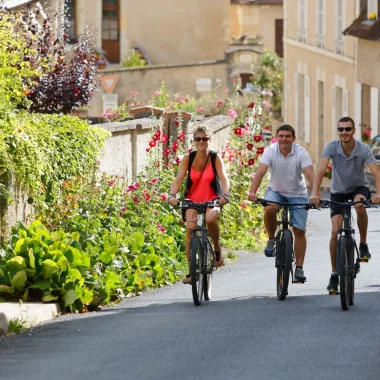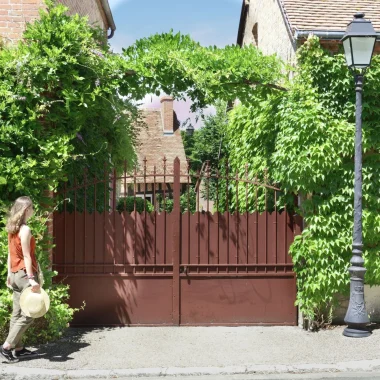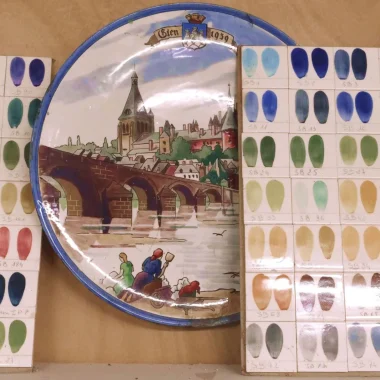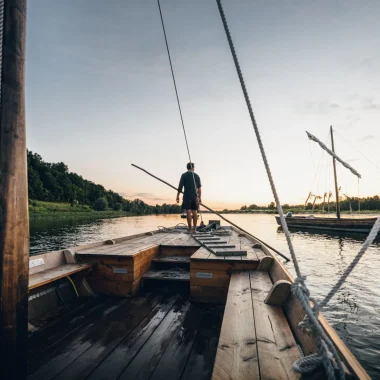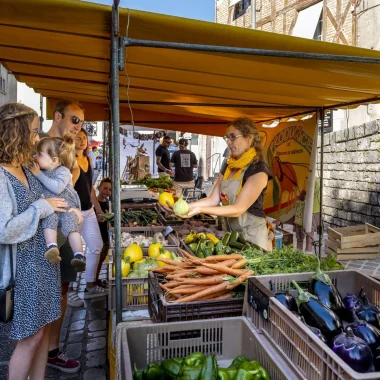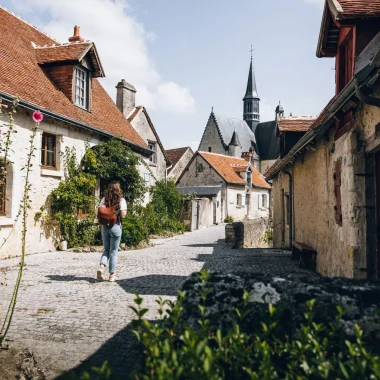Here are 8 Loire châteaux to visit near Tours. Whether it’s your first visit or not, each of these châteaux has some great surprises in store for you!
The Royal City of Loches
The elegant Royal City of Loches overlooks the town and is one of the Loire châteaux to visit near Tours. Stroll through its narrow streets and alleys. They will take you to the royal residence and the keep. The elegant silhouette of the residence contrasts with the austerity of the keep. Push open the doors to enter into the history of these edifices and their illustrious hosts.
It is at the royal residence of Loches that Joan of Arc came to meet King Charles VII to persuade him to go and be crowned in Reims. The king also often stayed at the château, in the company of his mistress, the beautiful Agnès Sorel. His tomb, adorned with an alabaster recumbent, lies in the nearby collegiate church of Saint-Ours. Anne of Brittany, twice Queen of France, spent long periods of time in Loches. The flamboyant Gothic oratory was built upon her request, and decorated with her emblem: the ermine.
Just a few steps from the royal residence of Loches stands the imposing keep. It was built around the year 1000 by Foulques Nerra, and stands at 37 metres high. It was used as a royal prison from the 15th to 18th centuries and held many prisoners. The most famous of these was the Duke of Milan, Ludovico Sforza, who was held there for four years. His rank nevertheless allowed him to benefit from special conditions of detention. He was incarcerated in a private, heated cell. As well as being allowed out of his cell, he was also given the equipment he needed to pursue his passion: painting. The drawings he made on the walls have been restored, and there is even a sentence in his handwriting. The graffiti room also bears witness to the passage of many other anonymous prisoners.
For an even more interactive and immersive visit, choose the Histopad® tour, which will take you to the heart of the history of the Royal City of Loches (Histopad included in the price of the ticket; if entering on a free ticket, tablet only: €5).
Discover all the events at the Royal City of Loches!
The Château of Chenonceau
Among the Loire châteaux to visit near Tours, the Château of Chenonceau, set in its own gardens, is a jewel of the Renaissance. Its famous gallery gracefully spans the waters of the Cher, giving it a silhouette like no other.
The château was built, managed and saved by women, and is also known as the “Château des Dames” in honour of those who watched over it. Among them was Diane de Poitiers, a mistress of King Henry II, who had the bridge built over the Cher. When the king died, his wife Catherine de Médicis forced Diane to leave the château. Echoing the Ponte Vecchio in her native Florence, the Queen had the famous two-level gallery built on the bridge.
The Château de Chenonceau cultivates the art of refinement. Furniture, tapestries and paintings by great masters make up a remarkable collection. But the Château des Dames also continues the tradition of floral decoration. Chenonceau is the only château in France to have its own floral workshop and is always adorned with splendid bouquets and floral creations. As the seasons go by, spring bouquets, arrangements of peonies, baskets of dahlias and, at the end of the year, magical Christmas arrangements, are created and produced by the florists, one of whom is a Meilleur Ouvrier de France.
Next to the château, the gardens of Diane de Poitiers and Catherine de Médicis demonstrate the French tradition of garden design. The Flower Garden is where the countless varieties used in the floral workshop are grown.
- Every year, take advantage of the magnificent display of flowers at the Château of Chenonceau. Stroll through the gardens of the great ladies of Chenonceau: Diane de Poitiers and Catherine de’ Medici. You will discover geometrically shaped shrubs and hundreds of rosebushes and hibiscus. Not to forget the brilliantly coloured flowers in the Flower Gardens, used by the floral workshop to compose the bouquets that adorn the different rooms of the château throughout the seasons.
- Take on the labyrinth and make your way to the gazebo at its centre. Then it’s up to you to find your way out!
- Tours, tastings and floral displays liven up the calendar at the Château of Chenonceau.
Discover all the events at the Château of Chenonceau!
The Château of Le Rivau
The Château of Le Rivau is surrounded by 15 enchanting gardens and looks like something out of a fairytale. A few kilometres from Chinon, Le Rivau harmoniously blends art, heritage, gardens and wonder! Another Loire château to visit near Tours.
With its high towers, drawbridge and surrounding moat, the Château of Le Rivau proudly displays its medieval architecture. In the château’s spacious rooms, works by contemporary artists feature alongside fine Gothic and Renaissance furniture. At the entrance to the courtyard, the Renaissance stables are among the oldest in France. It was here that horses destined for the kings of France were bred. Joan of Arc came here to fetch some horses before the Battle of Orléans. Inside, the ancient walls display audiovisual projections that pay tribute to equestrian art and to mythical and legendary horses.
Monumental sculptures have been installed in the gardens of the Château of Le Rivau. Two huge wellington boots, a gigantic watering can, a giant mole emerging from the earth in the Gargantua Kitchen Garden… These contemporary artistic creations are installed throughout the gardens. The Little Thumbling Garden, the Love Potion Garden, the Enchanted Forest Garden, the Orchard of Paradise… these 15 gardens will take you on a wonderful journey.
Roses take pride of place at the Château of Le Rivau. This collection brings together 450 varieties of roses selected for their fragrance. Their delicate scent perfumes the gardens. The Pilgrim, with its scents of tea and myrrh, has saffron-coloured petals, while Lady Emma Hamilton, with its beautiful orange-mandarin-coloured petals, has fruit salad scents. As for Château du Rivau, designed by the famous rose gardener André Eve, it spreads its pretty vines out covered in white roses with golden stamens and smells of green apples.
Discover all the events at the Château of Le Rivau!
The Château of Clos-Lucé
This is another of the Loire châteaux to visit near Tours. In the heart of Amboise, the Château of Clos Lucé was once the home of Leonardo da Vinci. The Italian genius was invited to France by Francis I and settled in this elegant pink-brick château in 1516.
From its apartments to its restored workshops, the visit to the Château of Clos Lucé takes you into the world of the greatest genius of the Renaissance. You will see the spacious room where he received his guests, the kitchen where he savoured the healthy vegetarian dishes prepared by his servant Mathurine, and his bedroom with a view of the Royal Château of Amboise; they all hold the memory of the Master. On the ground floor of the château, models and 3D animations give an insight into the scope of Leonardo da Vinci’s research.
His workshops have been faithfully recreated to explain what a typical day was like for Leonardo da Vinci. From morning until night, the Master would set himself up to work on his projects and studies. Drawings, the artist’s tools, his pigment table and a library full of facsimiles and old books all bear witness to the studious atmosphere in which you can almost see him working.
Outside the Château of Clos Lucé, the Leonardo da Vinci Park also evokes the Master’s inventions. The aerial screw, the swing bridge, the tank and the squirrel wheel are all based on sketches by Leonardo da Vinci. These giant machines are made using the materials of the time, and you can operate them yourself! Alongside them, some forty immense translucent canvases are displayed: portraits, views, drawings of botany, anatomy or civil and military engineering take you a little further into the Master’s various studies.
In the park, discover the cultural and museum area “Leonardo da Vinci, Painter and Architect”. Open since 2021, the 500 m² exhibition space showcases the two major facets of Leonardo da Vinci’s work: Leonardo da Vinci the painter and Leonardo da Vinci and architecture.
The Royal Château of Amboise
One of the essential Loire châteaux to visit near Tours: home to the kings of France during the Renaissance, the Royal Château of Amboise towers high above the Loire. From the top of its terraces, it offers an exceptional panoramic view of the river.
The Royal Château of Amboise was the residence of the Kings of France in the 15th and 16th centuries. It was also where the royal children grew up. Charles VIII was born in the château and brought back the first influences of the Renaissance from Italy. During his reign, Francis I, who spent his childhood there, embellished the château, where he often stayed. Winner of the Italian campaigns and a great patron and lover of art, he surrounded himself with many artists. Among them was Leonardo da Vinci, whom he invited to France and hosted at the Château of Clos Lucé, just a stone’s throw from the Royal Château.
A range of options are available for exploring the Royal Château of Amboise. Take an immersive tour using the Histopad, a guided tour, a self-guided tour or a family tour. You will have the chance to explore the monument, from the royal apartments to the Great Council chamber. One of these tours will take you from the underground spaces to the top of the Tour Cavalière des Minimes. The ramp on this tower allowed horses and carriages to reach the top. From its vast terrace, it offers uninterrupted views of the river. In the grounds, the Saint-Hubert chapel houses the tomb of Leonardo da Vinci, who died at the Château of Clos Lucé on 2 May 1519.
At the foot of the château, the Naples Garden evokes the Italian origins of the first garden created by Dom Pacello de Mercogliano. This Neapolitan monk and gardener was commissioned by Charles VIII to landscape the grounds of the Royal Château of Amboise at the end of the 15th century. Today, with its terracotta pots bordering vast flowerbeds, this garden whisks visitors away to an Italian atmosphere reminiscent of Medici villas.
Want to discover the Royal Château of Amboise on an immersive visit? It can be done! With a Histopad® in hand, you move around buildings that have now disappeared. Find out how the royal residence was refurbished. You will see masterpieces, now on display in museums around the world, back where they belong. And you’ll meet some amazing people, including the kings who made French history and the life of the château!
Discover all the events at the Royal Château of Amboise!
Visite guidée dans les coulisses de l’histoire au Château royal d’Amboise
The Royal Fortress of Chinon
From the top of the rocky spur on which it stands, the Royal Fortress of Chinon overlooks the Vienne. Behind its long ramparts, this ancient fortress has many stories to tell.
The Royal Fortress of Chinon is made up of three main châteaux: the Fort Saint-Georges, the Château of Milieu and the Fort du Coudray, and is surrounded by ramparts behind which it hosted many guests. Henry Plantagenet, King of England and husband of Eleanor of Aquitaine, died in the fortress in 1189. A few years later, the Grand Master of the Knights Templar, Jacques de Molay, was imprisoned there along with three other high dignitaries. The walls of the Coudray tower still bear the trace of graffiti engraved in the stone. In 1429, during the Hundred Years’ War, Joan of Arc came to Chinon to meet Charles VII.
You will be able to see the bedroom of Henry Plantagenet and Eleanor of Aquitaine. It is a meticulous reconstruction featuring royal seats, chests, a table and a royal bed covered in wild silk, faux fur and a 12th-century fabric preserved in the Musée d’Art et d’Histoire in Chinon.
It may be a thousand years old, but the Royal Fortress of Chinon offers you a visit at the cutting edge of technology! With a Histopad®, take a step back in time and immerse yourself in the fortress and its history. 360° 3D reconstructions will show you rooms that have since been transformed or have disappeared. Mangonels, catapults, cannons… you will be handling war machines. Take a virtual tour of the underground galleries of the Fort du Coudray. A fun tour for the whole family. Included in the château entrance fee, at no extra charge. €5 for those entitled to free entry to the site.
Discover all the events at the Royal Fortress of Chinon!
The Château and gardens of Villandry
Near Tours, the Château of Villandry is the last of the great châteaux built on the banks of the Loire. At its foot, its emblematic terraced gardens reveal the art of Renaissance gardens. Take a walk in the fresh air through these colourful verdant spaces!
The elegant silhouette of the Château of Villandry was built by Jean Le Breton, Minister of Finance under Francis I. A few centuries later, Joachim Carvallo, great-grandfather of the current owner, bought the château. With his wife Ann Coleman, he undertook an impressive project to restore the splendid French Renaissance gardens.
Among them, the Kitchen Garden is undoubtedly the most emblematic of the gardens at the Château of Villandry. Its nine squares of identical size form a colourful palette that changes with the seasons. Flowers and vegetables blend harmoniously, thanks to the work of the château’s team of gardeners.
On top of this chequerboard of colours, other gardens await you. At the foot of the château, the Salons in the Ornamental Garden are dedicated to Love and Music. A little further on, surrounded by vast lawns, the water mirror offers a romantic walk. The Sun Garden, on the highest of the terraces, was designed by Joachim Carvallo.
Laurent, the head gardener at the Château of Villandry, has been using organic methods for a long time. Chemical insecticides and fungicides have been banned. New insects have now taken up residence in the gardens, and they do a great job of combating pests. Old-fashioned tools such as the grelinette, the poussette and the paroir have also made a comeback. This was an initiative that pleased the birds, who have made the place their own. The Château of Villandry is now part of the LPO (French League for the Protection of Birds) network of bird sanctuaries.
The Château of Azay-le-Rideau
The Château of Azay-le-Rideau was compared by Balzac to “a faceted diamond set by the Indre”. And with good reason: the delicate silhouette of this Renaissance château is reflected in the peaceful mirror of water that surrounds it.
It was purchased in the 16th century by Gilles Berthelot, treasurer of King Francis I’s finances, and is a jewel of the Renaissance. A major restoration project has recently restored the château to its former glory. Its delicate decor, tufa stone facades and turrets topped with slate roofs are a delight.
During the Renaissance, it was a woman, Philippe Lesbahy, the wife of Gilles Berthelot, who took charge of the work on the Château of Azay-le-Rideau. Upstairs, her bedroom takes you back to the time of the Renaissance. The walls have been lined with woven rushes using Renaissance techniques. This technique retained warmth in rooms that were very difficult to heat at the time. A few centuries later, the art-loving de Biencourt family also took care of the château, which had suffered the torments of the Revolution. The large English-style grounds surrounding the château and its walkways were designed at their request. On the ground floor of the château, the Biencourt Room immerses you in the hushed atmosphere and savoir-vivre of the 19th century.
- Fun family visits: during the school holidays, the Château of Azay-le-Rideau offers a wide range of activities for young and old. Have fun discovering the Château of Azay-le-Rideau and its history as a family!
- Take a break at Le Lavoir, the château’s restaurant/tearoom. After strolling through the grounds and gardens, take a seat on the terrace for a while. You can enjoy refreshments or a meal made from fresh, local, seasonal produce.
Themes

